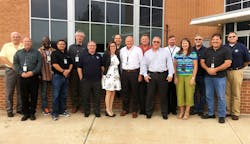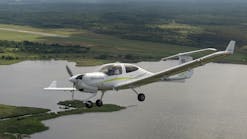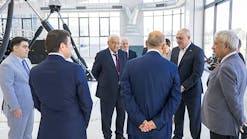There is a high demand for good human factors (HF) trainers. Every Inspection Authorization seminar, professional meeting, and formal gathering of aviation maintenance personnel dedicates some portion of the program to the topic of human factors. The FAA was faced with the challenge of a limited number of personnel dedicated to maintenance HF. However, FAA has a number of Safety Team program managers (FPM) who provide excellent presentations on a multitude of safety and technical topics. This article describes a recent FAA workshop/initiative that had the goal to sharpen the presentation skills to deliver maintenance human factors training and to create materials for those who teach or speak about maintenance human factors. The plan was to identify or develop training support that could be used by many.
Planning to Train the Trainer Workshop
The HF Train the Trainer workshop design team involved four organizations. The team included the chief scientist and technical advisor program (Dr. Bill Johnson), the Human Factors Branch of Civil Aerospace Medical Institute (Dr. Michelle Bryant), the Department of Transportation Safety Institute (TSI) (Mr. D Smith), and the National FAA Safety Team (FAAST) – Airworthiness (Jim Hein). The multi-disciplinary team was well-prepared to create and deliver the Train the Trainer for Maintenance Workshop (TTT). They recruited about 10 FAA Safety Team members and Flight Standards Managers to serve as instructors and beta-students for the workshop. For this workshop, all were learners.
The team knew that the workshop had to be as much about training delivery and public speaking as about HF content. Many FAA Safety Team members already have excellent experience delivering training on a variety of safety topics, including maintenance human factors. Therefore, the primary goal was to enhance their current delivery skill set and develop materials and instructional methods that would be useful for future TTT and HF courses.
The two-and-one-half-day workshop had three major sections to include: Fundamentals of Presenting (Day 1), Presentation of HF Topics (Day 2); and Applying the Techniques and Topics (Day 3). Everyone in the workshop made at least one presentation and was subjected to written checklist evaluation and discussion. That meant that the workshop was filled with high-value, professional, and constructive peer evaluations.
Fundamentals of Presenting
The first day was like a return to a college-level in the education department. Adults learn by doing and learn best when they know that they must apply that learning immediately. At the very start of the course each student was privately video taped introducing themselves to a fictitious large audience of maintenance personnel. In the 2.5-minute video they had to offer the reasons that they were qualified and motivated to teach a HF course. All shared the challenge of facing the video camera and speaking to an audience of zero. Upon group review to identify best communication methods, we found that the best intros were the ones that most closely adhered to the scripted instructions. Surprisingly, only 1 of 15 went beyond the time limit. During review we discussed such aspects as posture, body language, tone, enthusiasm, and more. The introduction exercise was enjoyable and high value.
Day 1 combined both practical information and learning theory. Topics ranged from adult learning theory – called Androgogy, by Inspector Jim Hein, to how to gather information about maintenance human factors issues. In that section Dr. Michelle Bryant emphasized that there is a lot of maintenance human factors information already available. One does not have to reinvent the wheel or seek a Ph.D. in human factors, to deliver an excellent presentation. Of course, she mentioned the FAA maintenance HF website (humanfactorsinfo.com). Johnson’s article about “Sources” (See AMT July 2016) was also mentioned. Everyone believed that the level of content detail must be matched to audience interest and requirements. Trainers should not try to present at a level beyond their knowledge/comfort. That situation will lead to embarrassment during the Q&A.
Once a trainer has the right materials they must present the information in a clear, correct, complete, and concise manner. Further, a good trainer must be able to facilitate discussion and keep "things interesting.” D Smith did just that by capitalizing on years of training experience for U.S. Army helicopter crews and more recently on accident investigation, human factors, and safety management for the Department of Transportation. Using a mix of Steve Jobs and Zen style, Smith's 25 slides contained about 50 words in total. See below about how to get copies of all the slides.
Inspector Keith Frable is a former FAA principal maintenance inspector for the two of the largest U.S. air carriers. He is also a 10+ year adjunct professor for the Embry-Riddle University Worldwide Campus. He applied his teaching and FAA experience to deliver training on FAA’s important topic of risk-based decision making (RBDM). He showed the interdependency between topics like safety management, RBDM, and FAA’s new compliance philosophy. He emphasized that a new FAA Flight Standards will look differently at how inspectors use enforcement and at how voluntary reporting is changing enforcement practices. He presented information to show that such changes will increase compliance, communication, and continuing safety.
Day one ended with a story. Well, it actually was a unit on “story telling” that emphasized the value of story delivery in HF courses. Drawing on techniques from TED talks and a lot of HF teaching experience Bill Johnson offered technique and stories from his 50 years as an aviator/trainer. He claimed that he is a humble match to the stories from most FAA safety inspectors. Johnson switched from teacher to learner at the start of Day 2, when every member had an option to tell a three-minute story. Stories were evaluated against a list of “tips” for story telling. The bottom line is that instructional stories are as much about delivery style as about the story content.
Combining Style and Content
On the second day there was more HF content. However, the primary focus was on how to teach specific HF content. Inspector/manager John (Jay) Hiles described the importance about knowing your audience and how to match content and language to the audience. A breakfast presentation to the Rotary Club is quite different that speaking about safety to a room full of experienced airline technicians. He showed how general aviation mechanics and owner-operators have different motivations than MRO employees. The good news is that everyone that flies as a passenger or pilot, manufactures or repairs aircraft, or oversees regulatory compliance is interested in the human factors that affect continuing safety.
Johnson believes that you can’t have an HF class without revisiting the PEAR Model. Of course he offered his “one slide” human factors course to include: Shell, Swiss Cheese, Dirty Dozen, Risk Assessment Model, Bowtie, and PEAR. He spoke about the variety of ways to combine the PEAR Model and story telling so that learners will have an easy way to recall a variety of human factors topics.
During the Day 2 mid-afternoon hours of daytime circadian low, Dr. Bryant lectured about human fatigue. Everyone stayed awake during her lecture discussion. There was quite a debate regarding the appropriate amount and complexity of how much science is necessary in a fatigue lecture to aviation maintenance technicians. The final resolve was that one must find the match between audience expectation and trainer knowledge and comfort. Most importantly, the audience should know the techniques to be aware of and compensate for fatigue. In the end Dr. Bryant recommended using the fatigue materials from www.humanfactorsinfo.com.
All training relies on excellent media, materials, and clear communication. Inspectors Gina Moretto and Steve Keesey covered these topics to include appropriate design and use of PowerPoint and other media. Keesey, a Texas-Oklahoma inspector, pilot, mechanic, and aircraft owner, applied his unique style to a great presentation. He emphasized the importance of straight talk, plain language to keep things simple and clearly communicated so people will understand and remember the important content/facts.
Applying the Principles to Deliver the Content
Day 3 was application day. We called it “Practical Exam Day,” since a room full of certified mechanics could relate to that. Ten inspectors applied the principles of Days 1 and 2 to deliver HF topical presentations. Topics included: Fatigue and Human Error; HF Self-Assessment; Human Factors Accidents; the Aviation Data Exchange; Communication; Work Environment for Visual Inspection; and more. All speakers were evaluated with checklists, also used for feedback and discussion.
Day 3 speakers were an absolute positive demonstration that the FAASafety Team has a lot of HF speaking talent. If you are looking to capitalize on the talent, please go to www.faasafety.gov to contact your local Safety Team airworthiness program manager. They will match the right workshop graduate to your location and information requirement. FAA HF speakers are qualified and “open for business,” to provide maintenance HF training.
More Information and Next Steps
The workshop was a success, based on delegate feedback. Participants liked the variety of topics and the combination of theory and practice. Most felt that the workshop could have been a couple of days longer. There was nearly unanimous agreement that the workshop should be converted to an annual offering for the FAA and or the public. All of the content from this workshop is posted and downloadable from the FAA Maintenance Human Factors Website (www.humanfactorsinfo.com), under “Training Materials.” At that site you can access information about the qualifications for a human factors instructor from the article: Aviation Mx FAA Human Factors Newsletter. Volume 1 Issue 2, June 2013.






